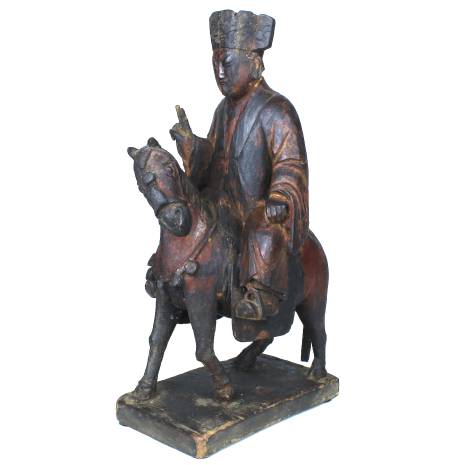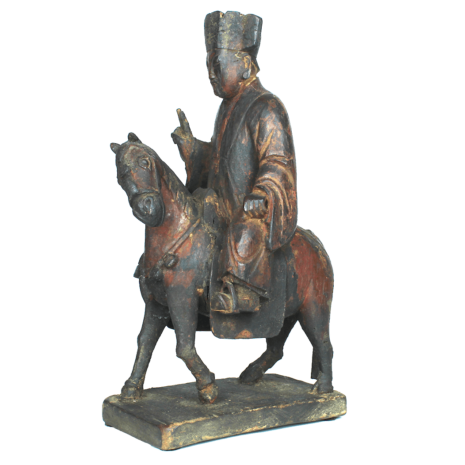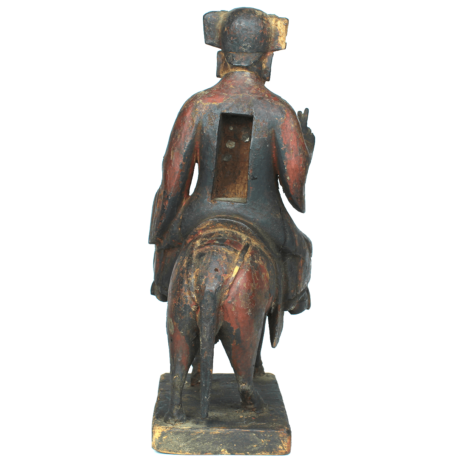Antique Taoist Priest on a Horse, China (16085)
Original price was: $795.00.$595.00Current price is: $595.00.
H: 13″ W: 4″ D: 7″ | FREE SHIPPING WITHIN CONTINENTAL U.S.
Taoist priest wearing a winged hat with a taotie warning against excess, and hands in the Sword Gesture used to cast out evil and offer blessings. Often on horses, priests were models of morality reflecting the Way of the Tao stressing harmony and oneness with nature.
Description
This fine carving is a Taoist priest in official’s attire astride a lively horse. Taoist priests and masters, viewed as models of morality protecting devotees by casting out demonic or malevolent spirits, were often depicted on horses reflecting the Way of the Tao that stresses harmony and oneness with nature and the elegance of nature personified by horses.
The priest’s pendulous ears reflect his wisdom and enlightenment. He is dressed in traditional priest’s garb; an overcoat is clasped at the waist and stretches to just above the feet with draped sleeves. His double winged high hat is centered with an image of a taotie , a mythical figure of a face with an open gaping mouth, a motif often found on ancient Chinese bronze vessels. According to legends, the taotie is said to have had such an appetite that it even eats its own head. It is also said to represent greed and sometimes is viewed as a guardian figure placed on the robes of religious officials to be a warning against excess. .
His hand is raised with two fingers up in the Taoist Sword Gesture (prana mudra) that Stephen Little (p. 192) calls “a beneficial ritual gesture,” symbolizing the energetic link of heaven and earth, consistent with the Taoist belief of uniting natural energies. Also called the Sword Gesture, it is used to cast spells, offer blessings, and sanctify and empower Taoist talismans.
His horse has a neck strap/breast plate around his neck with five suspended round objects, possibly bells hanging at his chest. The horse moves at a slow gait, front left leg bent, head tilted to the side and with the tail extended to the base of the sculpture. Taoist personages are often depicted on horses, reflecting the belief that the Way of the Tao stresses oneness with nature. Ritter emphasizes the use of horses in symbolizing the harmony and elegance of nature stating, “ “The dressage artist rides and trains in harmony with Nature – at one with the Tao – which gives his horses and his work radiance and expressiveness. The converse is equally true. Where the laws of Nature are violated, beauty is lost, and horse and rider become caricatures.”
This statue may have originally been placed on an altar containing a mix of Taoist, Buddhist and popular religion deities along with ancestral tablets and figures. Taoist officials are regarded as masters whose teachings can lead devotees to immortality through yoga, breathing, exercises, chemical and herbal mixtures and union with the Celestial world. Priests, such as this image, may specialize in divination, oracular interpretation, the pursuit of higher knowledge, the quest for immortality or a combination of these endeavors.
The carving is in very good condition for its age and use. Some of the red, black and brownish hues with a lacquer finish have faded due to the natural oxidation of lacquer and from smoke from incense and candles burned in front of the image.There are some losses to the base The cavity in the back of the carving indicates it was consecrated by a Taoist priest in an eye opening ceremony.
Click Here for the Consecrating Wood Images Blog.
Sources
Terese Tse Bartholomew, Hidden Meanings in Chinese Art, San Francisco, Asian Art Museum of San Francisco, 2006.
Stephen Little, Taoism and the Arts of China, Berkeley, University of California Press, 2000.
Po Sung-Nien and David Johnson, Domesticated Deities and Auspicious Emblems: The Iconography of Everyday Life in Village China, Chinese Popular Culture Project, 1992.
Dr. Thomas Ritter, The Tao of Horsemanship – Chapter One
-2005www.artisticdressage.com/articles/tao1.html
Patricia Bjaaland Welch, Chinese Art: A Guide to Motifs and Visual Iconography, North Clarendon, Vt., Tuttle Publishing, 2008.
Additional information
| Dimensions | 16 × 12 × 8 in |
|---|---|
| Place of Origin | China |
| Period | Antique, Qing Dynasty |
| Date | 18th century |
| Materials and Technique | Wood |
| Dimensions (inches) | Ht: 13" W: 4" D: 7" |
| Dimensions (metric) | Ht: 53.34cm W: 10.16cm D: 17.78cm |
| Weight | 2 lbs 2oz |
| Condition | Very good, patina and wear consistent with age and use |
| Item Number | 16085BCK |
| Shipping Box Size | |
| Width | 6” to 11.9” |












